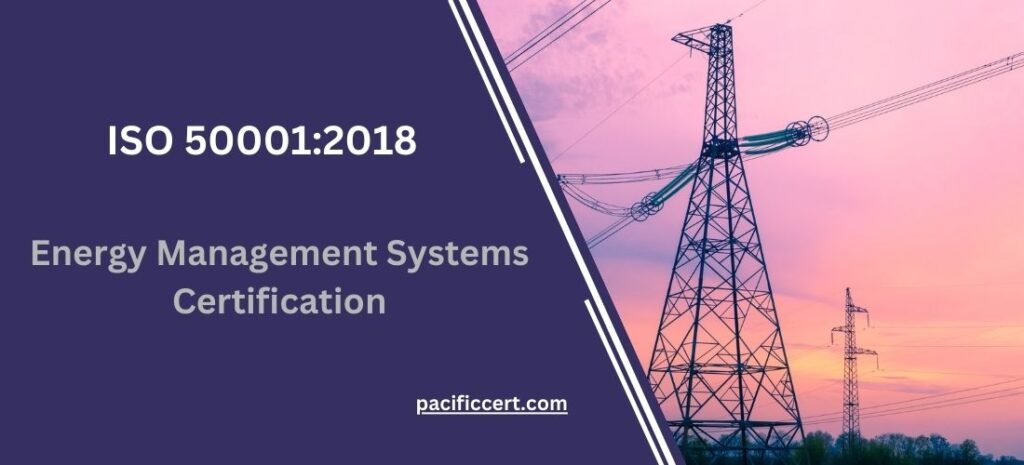
What is ISO 50001:2018- Energy Management Systems Certification?
ISO 50001:2018 is the international standard for Energy Management Systems (EnMS), provides organizations with a structured framework to manage and improve their energy performance. The overarching goal of ISO 50001 is to enable organizations to establish the systems and processes necessary to improve energy efficiency, reduce costs, and enhance environmental performance.
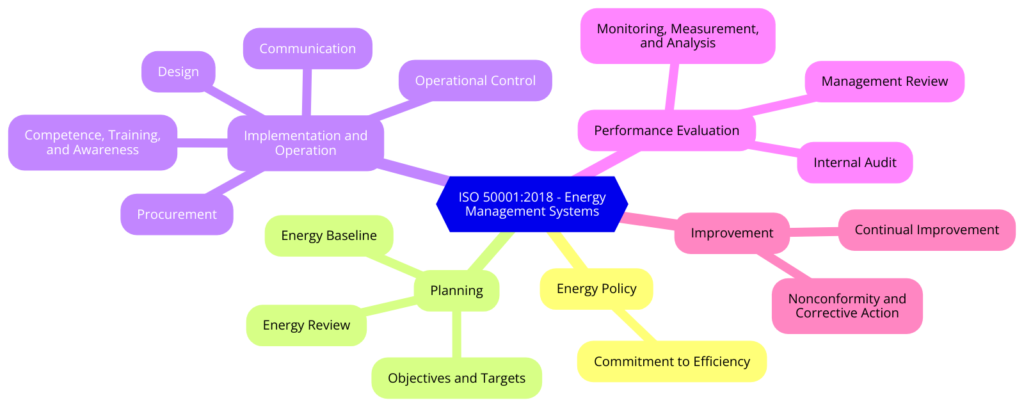
ISO 50001 is crucial because it provides a systematic framework for organizations to improve their energy performance, including energy efficiency, use, and consumption. Implementing ISO 50001 helps organizations identify areas where energy can be used more efficiently, leading to significant cost savings and a reduction in greenhouse gas emissions.
For ISO 50001 certification, please contact us today at support@pacificcert.com.
What are the Key Elements of ISO 50001:2018 – Energy Management Systems
ISO 50001:2018 encompasses several key elements that collectively enable an organization to establish, implement, maintain, and improve an Energy Management System. Below are the main components:

- Context of the Organization
- Leadership
- Planning
- Support
- Operation
- Performance Evaluation
- Improvement
With ISO 50001 organizations can achieve significant energy savings, reduce environmental impact, and enhance their overall sustainability.
Structure of ISO 50001:2018 – Clause wise
Clause 4: Context of the Organization
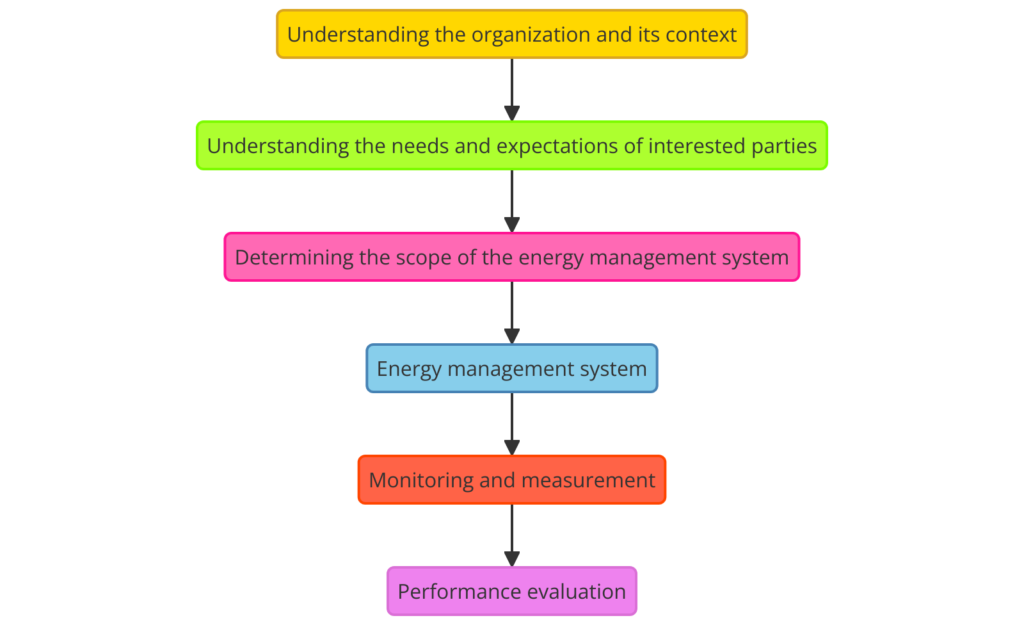
- 4.1 Understanding the Organization and its Context: Identifying internal and external issues relevant to the EnMS.
- 4.2 Understanding the Needs and Expectations of Interested Parties: Determining the requirements of interested parties that are relevant to the EnMS.
- 4.3 Determining the Scope of the Energy Management System: Establishing the boundaries and applicability of the EnMS.
- 4.4 Energy Management System: Establishing, implementing, maintaining, and continually improving the EnMS.
Clause 5: Leadership
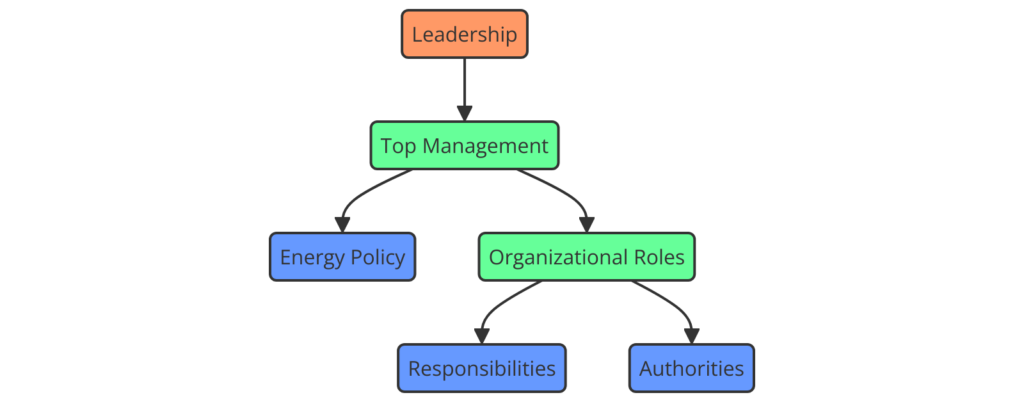
- 5.1 Leadership and Commitment: Top management must demonstrate leadership and commitment to the EnMS.
- 5.2 Energy Policy: Establishing an energy policy that supports the EnMS.
- 5.3 Organizational Roles, Responsibilities, and Authorities: Ensuring that roles and responsibilities are assigned and communicated within the organization.
Clause 6: Planning

- 6.1 Actions to Address Risks and Opportunities: Determining risks and opportunities that need to be addressed to ensure the EnMS achieves its intended outcomes.
- 6.2 Energy Review: Conducting an energy review to analyze energy use, consumption, and significant energy uses.
- 6.3 Energy Performance Indicators (EnPIs): Establishing EnPIs to monitor energy performance.
- 6.4 Energy Baseline: Establishing a baseline to compare energy performance.
- 6.5 Planning for Collection of Energy Data: Planning the collection of data to support the energy review and monitoring of EnPIs.
- 6.6 Objectives, Energy Targets, and Planning to Achieve Them: Setting measurable energy objectives and targets and planning actions to achieve them.
Clause 7: Support
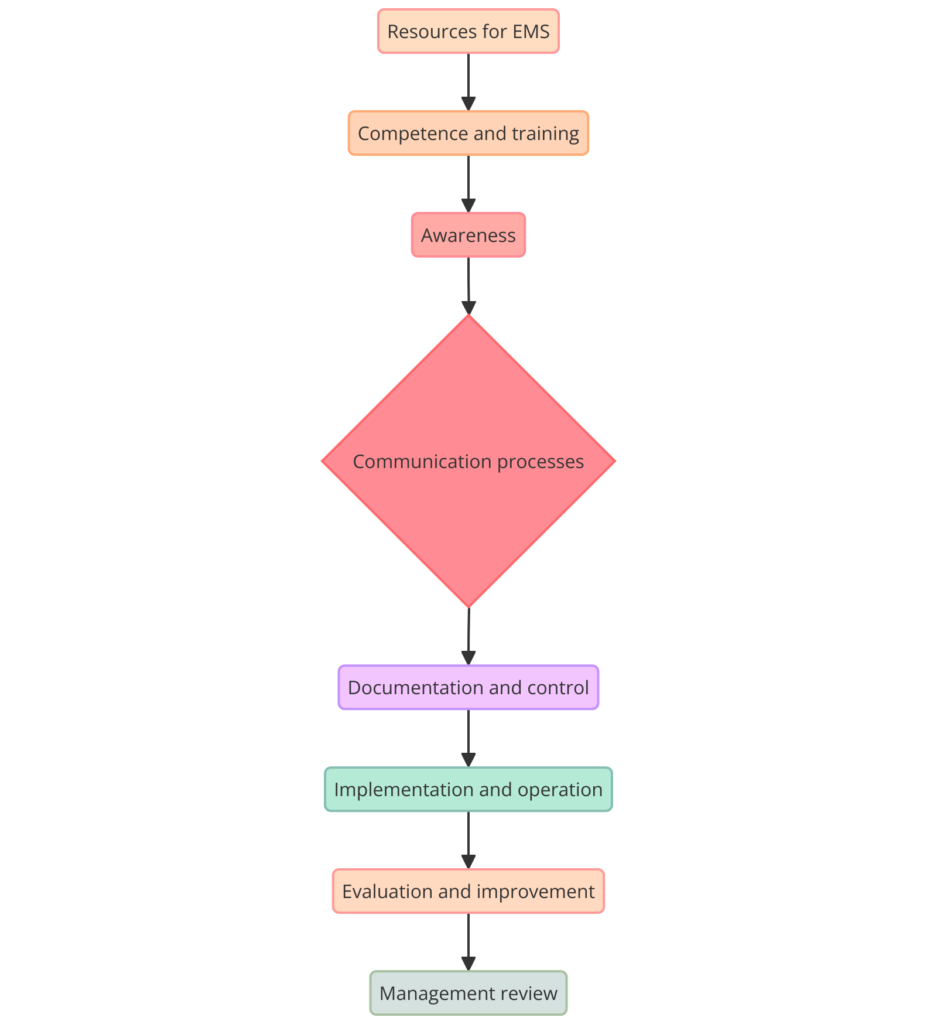
- 7.1 Resources: Determining and providing the resources needed for the establishment, implementation, maintenance, and continual improvement of the EnMS.
- 7.2 Competence: Ensuring personnel are competent on the basis of appropriate education, training, or experience.
- 7.3 Awareness: Ensuring personnel are aware of the energy policy, their roles, and the benefits of improved energy performance.
- 7.4 Communication: Establishing internal and external communication processes relevant to the EnMS.
- 7.5 Documented Information: Maintaining and controlling documented information required by the EnMS and the standard.
Clause 8: Operation
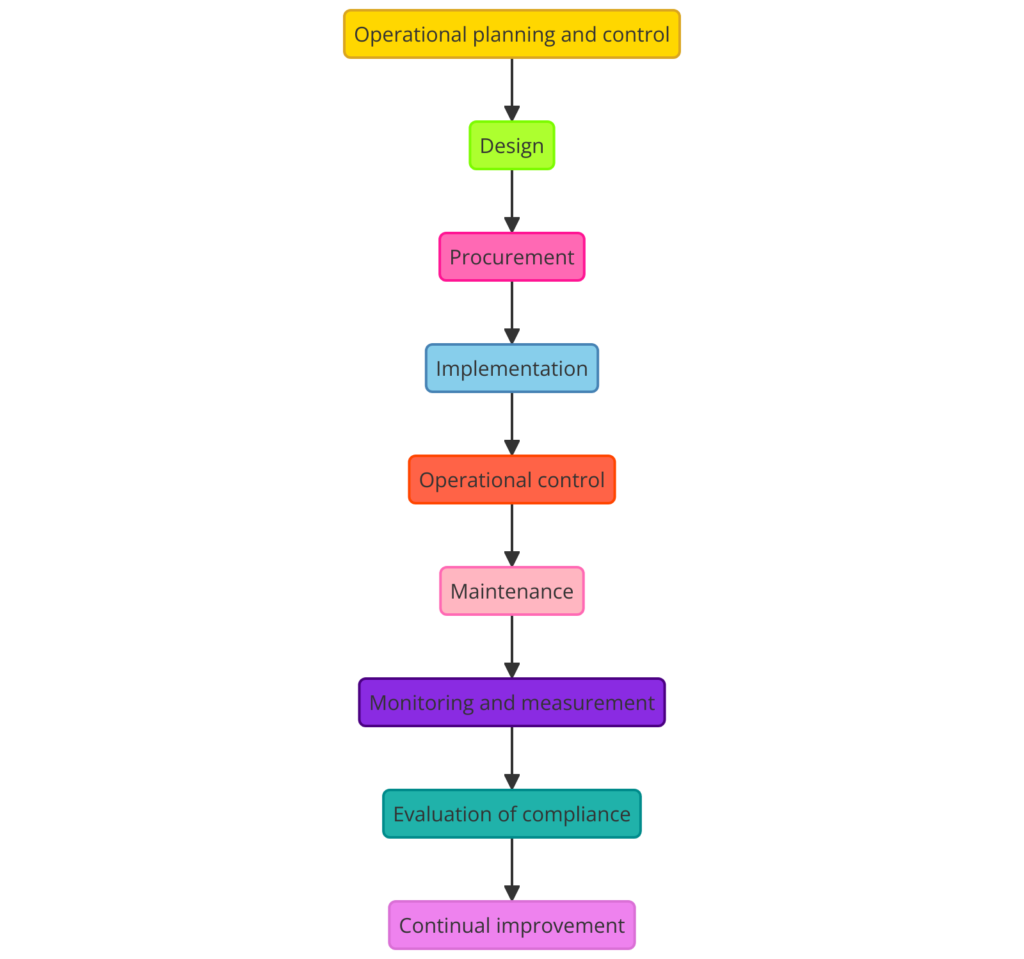
- 8.1 Operational Planning and Control: Implementing processes to achieve energy objectives and targets.
- 8.2 Design: Considering energy performance improvement opportunities in the design of new, modified, and renovated facilities, equipment, systems, and processes.
- 8.3 Procurement: Controlling procurement processes to ensure purchased products and services meet specified energy performance criteria.
Clause 9: Performance Evaluation
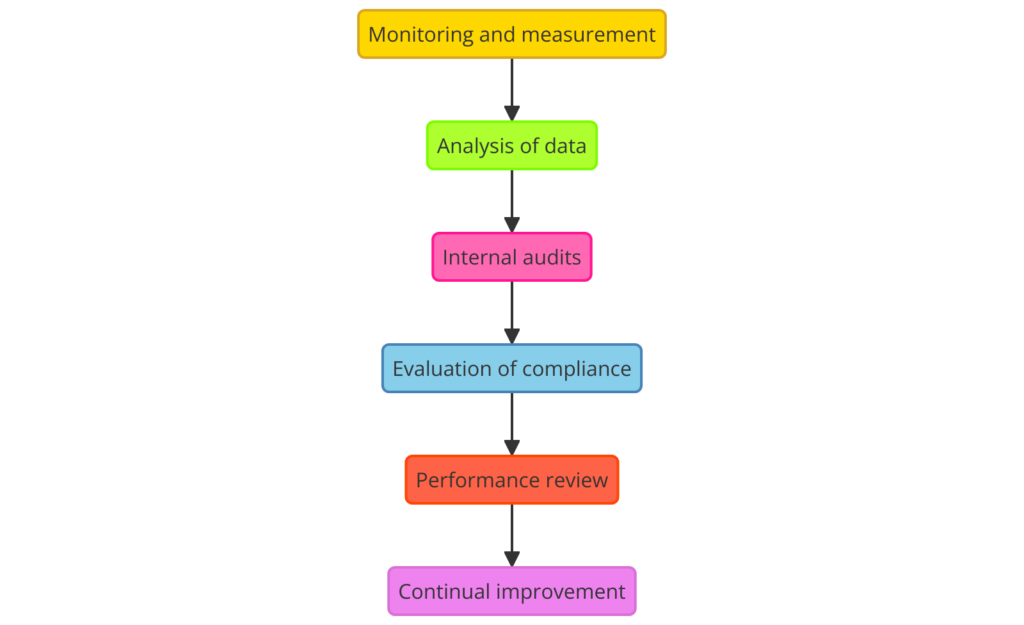
- 9.1 Monitoring, Measurement, Analysis, and Evaluation of Energy Performance and the EnMS: Monitoring and measuring key characteristics of energy performance.
- 9.2 Internal Audit: Conducting internal audits at planned intervals to provide information on whether the EnMS conforms to the organization’s requirements and the standard.
- 9.3 Management Review: Top management reviewing the EnMS at planned intervals to ensure its continuing suitability, adequacy, and effectiveness.
Clause 10: Improvement
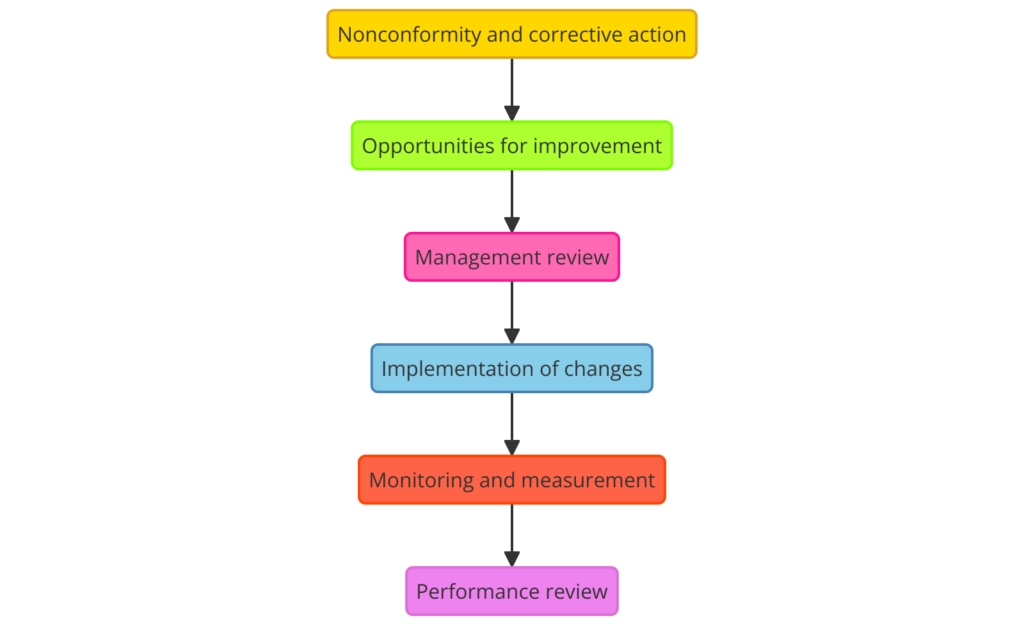
- 10.1 Nonconformity and Corrective Action: Taking action to eliminate the causes of nonconformities and prevent their recurrence.
- 10.2 Continual Improvement: Continuously improving the suitability, adequacy, and effectiveness of the EnMS and enhancing energy performance.
By following this structure, organizations can effectively establish, implement, maintain, and continually improve their energy management systems, leading to enhanced energy performance and sustainable energy use.
Ready to boost your energy efficiency with ISO 50001? Drop us a line at support@pacificcert.com to get started.
Audit Checklist for ISO 50001:2018: Clause-wise
Below is a clause-wise checklist to facilitate the auditing process:
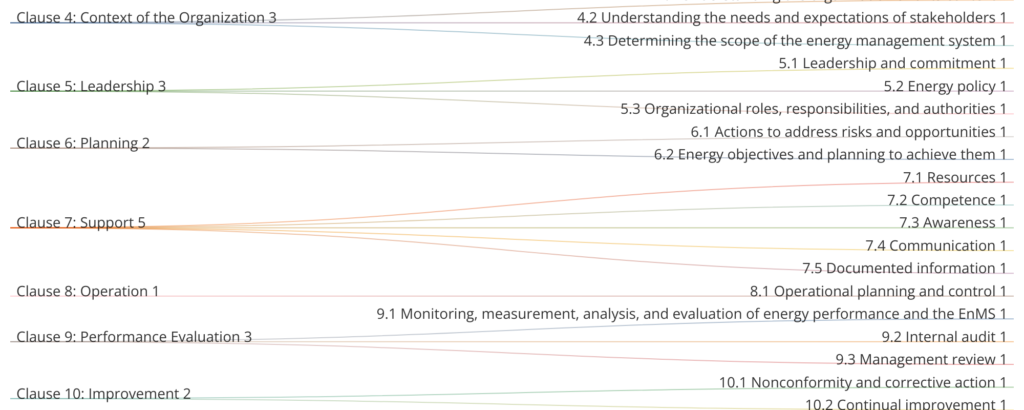
Clause 4: Context of the Organization
- Have internal and external issues relevant to the EnMS been identified?
- Are these issues documented and regularly reviewed?
- Have interested parties and their relevant requirements been determined?
- Are these needs and expectations documented?
- Is the scope of the EnMS clearly defined and documented?
- Does the scope consider the boundaries and applicability of the EnMS?
- Has the EnMS been established, implemented, maintained, and continually improved?
- Are processes and interactions needed for the EnMS determined and documented?
Clause 5: Leadership
- Is top management demonstrating leadership and commitment to the EnMS?
- Are there records of top management involvement in the EnMS?
- Is there an established and documented energy policy?
- Is the policy communicated, understood, and maintained within the organization?
- Are roles, responsibilities, and authorities for the EnMS clearly defined and communicated?
- Are there documented evidence and records of these roles and responsibilities?
Clause 6: Planning
- Have risks and opportunities related to the EnMS been identified and documented?
- Are actions to address these risks and opportunities planned and implemented?
- Is there a documented energy review process?
- Are significant energy uses (SEUs) identified and analyzed?
- Are EnPIs established and documented?
- Are these indicators regularly monitored and reviewed?
- Is there an established energy baseline?
- Is the baseline reviewed and updated as necessary?
- Is there a plan for the collection of data to support the energy review and monitoring of EnPIs?
- Are data collection processes and responsibilities documented?
- Are energy objectives and targets established and documented?
- Are there plans in place to achieve these objectives and targets?
Clause 7: Support
- Are resources required for the EnMS determined and provided?
- Are records of resource allocation maintained?
- Are personnel involved in the EnMS competent based on education, training, or experience?
- Are competence records maintained?
- Are personnel aware of the energy policy, their roles, and the benefits of improved energy performance?
- Are awareness programs documented?
- Are internal and external communication processes related to the EnMS established and documented?
- Are communications regarding energy management activities maintained?
- Is documented information required by the EnMS established and maintained?
- Are there controls in place for the creation, updating, and control of documented information?
Clause 8: Operation
- Are processes to achieve energy objectives and targets planned and controlled?
- Are operational controls for SEUs documented and implemented?
- Are energy performance improvement opportunities considered in the design of new, modified, and renovated facilities, equipment, systems, and processes?
- Are design processes documented and controlled?
- Are procurement processes controlled to ensure that purchased products and services meet specified energy performance criteria?
- Are procurement records maintained?
Clause 9: Performance Evaluation
- Are key characteristics of energy performance monitored and measured?
- Are monitoring and measurement processes documented and records maintained?
- Are internal audits conducted at planned intervals?
- Are audit results documented and actions taken to address nonconformities?
- Are management reviews conducted at planned intervals?
- Are review inputs and outputs documented and actions taken as necessary?
Clause 10: Improvement
- Are nonconformities identified and corrective actions taken?
- Are records of nonconformities and corrective actions maintained?
- Are there processes in place to continually improve the suitability, adequacy, and effectiveness of the EnMS?
- Are continual improvement actions documented?
Organizations can systematically evaluate the effectiveness of an organization’s Energy Management System, ensuring that all necessary elements are in place and functioning correctly with the help of the list above, also helps them to prepare for the certification body audit.
To begin your journey towards ISO 50001 certification, reach out to our team at support@pacificcert.com for expert assistance!
Plan-Do-Check-Act (PDCA) Explained: ISO 50001:2018
The Plan-Do-Check-Act (PDCA) cycle provides a structured approach to continuous improvement in energy management systems (EnMS). The cycle consists of four stages: Plan, Do, Check, and Act. Each stage encompasses specific actions to ensure that energy performance is systematically managed and improved over time.
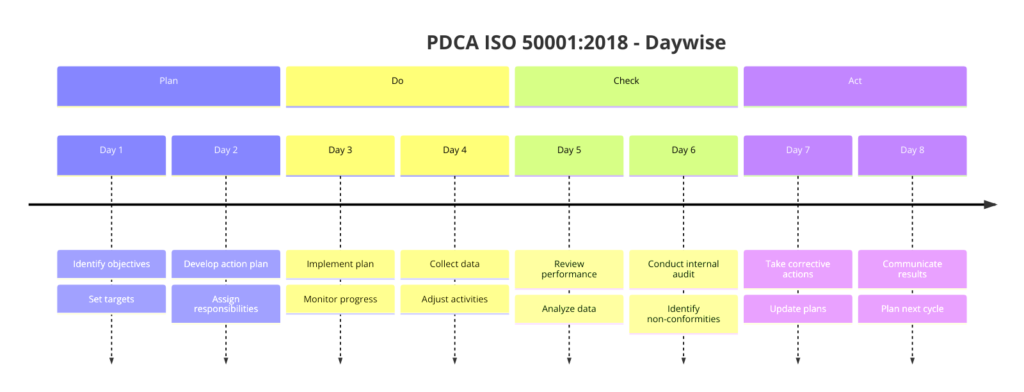
Plan
The Plan stage involves establishing the objectives and processes necessary to deliver results in accordance with the organization’s energy policy. It sets the foundation for the EnMS and includes the following activities:
- Understanding the Context (Clause 4)
- Leadership Commitment (Clause 5)
- Planning Actions (Clause 6)
Do
The Do stage involves the implementation of the plans and processes established in the Plan stage. This stage focuses on operational activities and the allocation of resources. Key activities are:
- Resource Allocation and Support (Clause 7)
- Operational Controls (Clause 8)
Check
The Check stage involves monitoring, measuring, and evaluating energy performance and the effectiveness of the EnMS. This stage ensures that the organization tracks progress and identifies areas for improvement. Key activities include:
Performance Monitoring (Clause 9)
Management Review (Clause 9.3)
Act
The Act stage involves taking corrective actions based on the findings from the Check stage to ensure continual improvement. This stage closes the PDCA cycle and prepares the organization for the next iteration. Key activities are:
- Corrective Actions (Clause 10.1)
- Continual Improvement (Clause 10.2)
The PDCA cycle is a core principle of ISO 50001, promoting a structured and systematic approach to energy management. The PDCA cycle helps in achieving energy objectives and targets and fosters a culture of continuous improvement within the organization.
Don’t wait to enhance your energy management. Contact us now at support@pacificcert.com for ISO 50001 certification.
Global Trends in ISO 50001 Adoption and Benefits for Companies
The adoption of ISO 50001, the international standard for energy management systems (EnMS), has seen significant growth from 2017 to 2024, driven by the increasing need for energy efficiency, cost reduction, and sustainability.
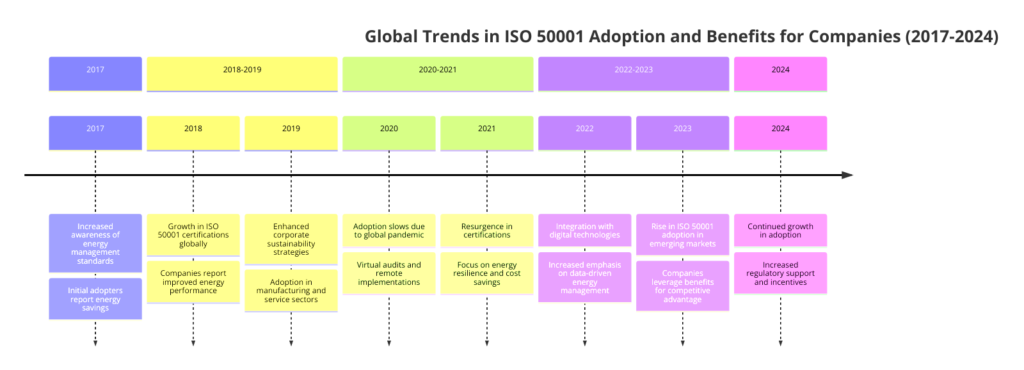
The early years saw a steady increase in ISO 50001 certifications, particularly in energy-intensive industries such as manufacturing, utilities, and large corporations. By 2017, more than 20,000 facilities globally had adopted ISO 50001, motivated by the need to control costs, improve energy efficiency, and enhance competitiveness. The U.S. Department of Energy (DOE) played an important role in promoting ISO 50001 through programs.
Implementing ISO 50001 has led to substantial cost savings and improved energy performance. A DOE analysis of facilities certified to this standard reported annual cost savings ranging from $36,000 to $938,000. These facilities achieved an average 12% reduction in energy costs within 15 months and energy performance improvements of 5.6% to 30.6% over three years. The standard’s focus on continuous improvement ensures that these benefits are sustained and enhanced over time (Plant Engineering).
ISO 50001:2018 supports environmental sustainability by reducing greenhouse gas emissions and other environmental impacts associated with energy use. Companies that adopt the standard contribute to global efforts to mitigate climate change, aligning with CSR objectives and enhancing their environmental stewardship. This alignment with sustainability goals can also attract environmentally conscious customers and investors (Energy in Demand).
The recent years have witnessed a significant increase in the adoption of ISO 50001, driven by the need for improved energy efficiency, cost savings, and alignment with global sustainability goals.
ISO 50001 Certification Requirements: Implementing ISO 50001
The ISO 50001 certification ensures that an organization meets the requirements of the standard. Here are the key requirements:
Leadership and Commitment
- Top Management Involvement
- Energy Policy
Planning
- Energy Review
- Energy Baseline
- Energy Performance Indicators (EnPIs)
- Objectives, Targets, and Action Plans
Support
- Resources
- Competence and Training
- Awareness and Communication
- Documented Information
Operation
- Operational Planning and Control
- Design
- Procurement
Performance Evaluation
- Monitoring, Measurement, Analysis, and Evaluation
- Internal Audit
- Management Review
Improvement
- Nonconformity and Corrective Action
- Continual Improvement
Need ISO 50001 certification? Contact us at support@pacificcert.com for more information!
Steps to Achieve ISO 50001:2018 Certification
Achieving ISO 50001:2018 certification involves a systematic approach to establishing, implementing and maintaining an Energy Management System. Here are the steps to the certification process:
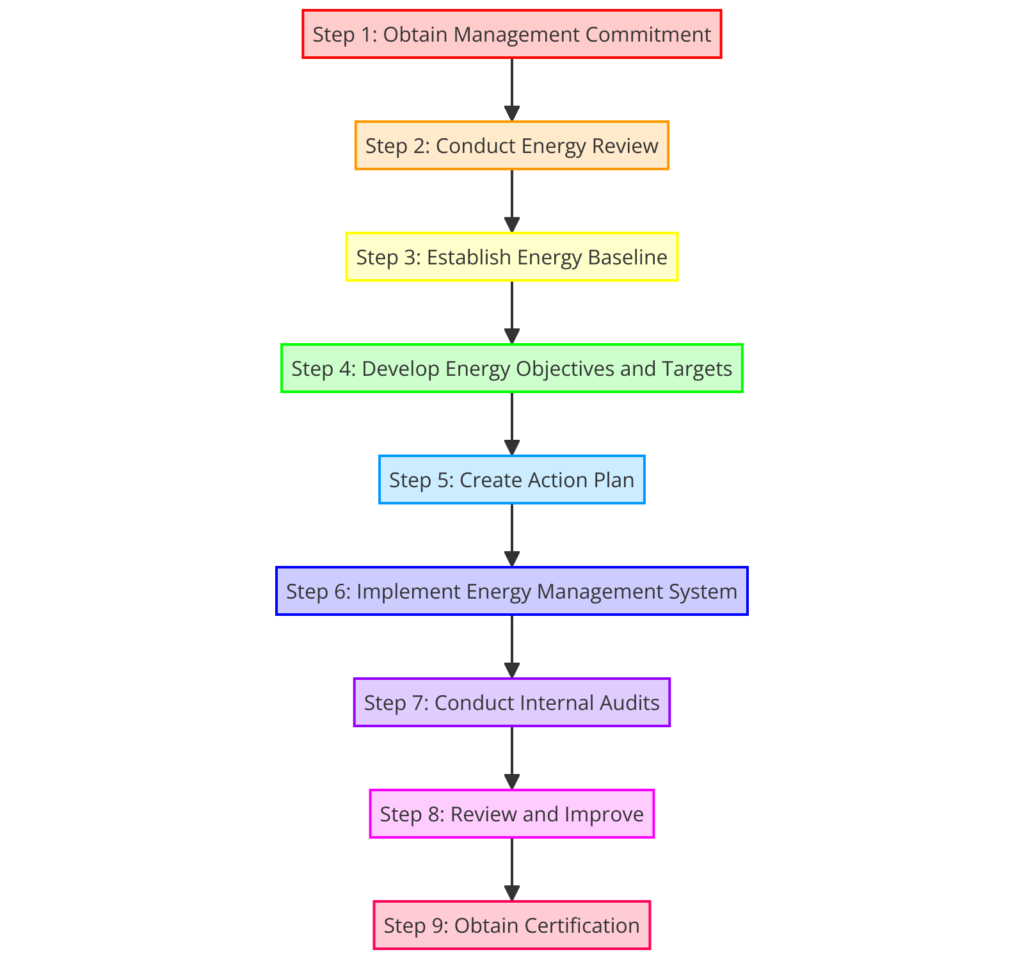
- Conduct a Gap Analysis
- Obtain Top Management Commitment
- Establish an Energy Team
- Define the Scope and Boundaries of the EnMS
- Develop an Energy Policy
- Conduct an Energy Review
- Establish Energy Performance Indicators (EnPIs) and Baseline
- Set Objectives and Targets
- Develop Action Plans
- Implement Operational Controls
- Provide Training and Raise Awareness
- Document the EnMS
- Monitor and Measure Energy Performance
- Conduct Internal Audits
- Management Review
- Apply for Certification
- Maintain and Improve the EnMS
Following these steps systematically can help organizations achieve ISO 50001:2018 certification, demonstrating their commitment to energy efficiency and sustainability.
Take the first step towards ISO 50001 certification. Email us today at support@pacificcert.com to learn how we can help!
What are the Benefits of ISO 50001:2018 Certification: Market Trends and Company Examples
ISO 50001:2018 helps organizations improve their energy performance, reduce costs, and enhance sustainability. Over the years, the adoption of ISO 50001 has seen substantial growth globally, driven by increased awareness of energy efficiency and sustainability.
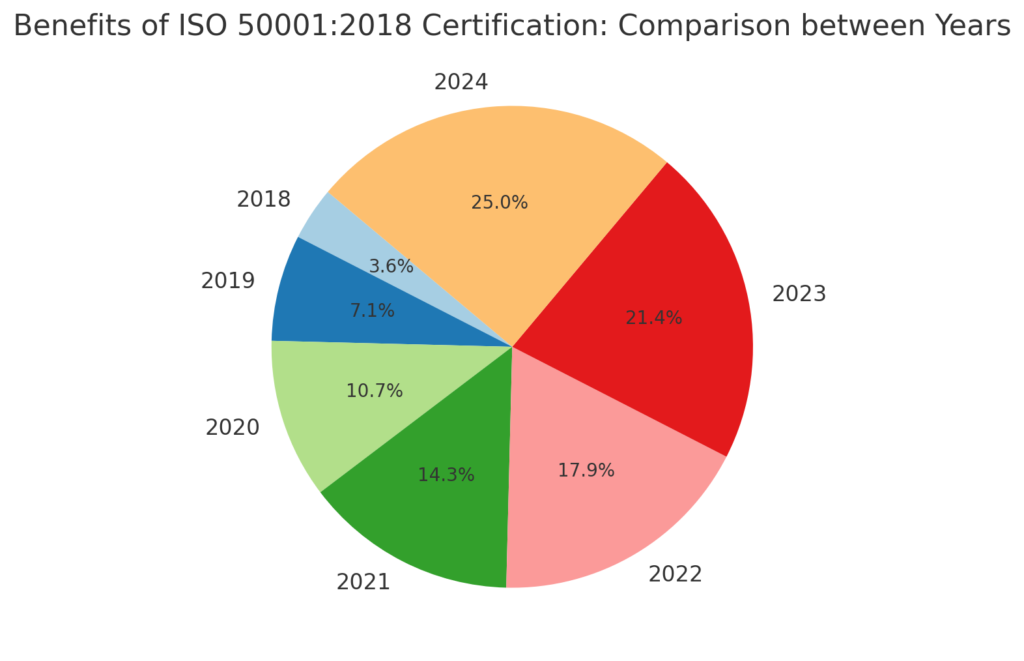
The number of ISO 50001 certifications has steadily increased, with over 43,000 sites certified worldwide as of 2023. This growth is expected to accelerate this year as more companies recognize the benefits of systematic energy management and seek to align their practices with global sustainability goals.
Other Benefits are:
- Helps organizations identify and manage their energy use more effectively, leading to significant cost savings.
- Optimizes energy consumption and reducing waste, organizations can lower their energy bills.
- Provides a systematic approach to monitor, measure, and manage energy use.
- Helps organizations comply with these regulations
- Certification to ISO 50001 demonstrates an organization’s commitment to sustainability and environmental responsibility.
- Organizations can reduce their exposure to energy supply risks and price volatility.
- Improved energy efficiency directly translates to reduced greenhouse gas emissions and other environmental impacts.
- ISO 50001 is recognized worldwide, making it easier for organizations to expand into new markets
- ISO 50001 encourages a strategic approach to energy management, aligning energy policies with organizational goals and objectives.
By adopting this standard, organizations can achieve significant operational, financial, and environmental benefits, contributing to long-term sustainability and resilience.
What is the Process of ISO 50001:2018 Certification?
The process of ISO 50001:2018 certification involves several steps. Here is an overview of the typical certification process:
Familiarize Yourself with ISO 50001:2018: Begin by understanding the requirements and principles outlined in the ISO 50001:2018 standard. It is essential to comprehend the key elements and expectations of the standard before initiating the certification process.
Establish an Energy Management System (EnMS): Implement an EnMS within your organization based on the requirements of ISO 50001:2018. This involves developing an energy policy, setting objectives and targets, and conducting an energy review. Also, establishing energy baselines, and identifying energy-saving opportunities.
Internal Readiness Assessment: Perform an internal audit to evaluate the effectiveness of your EnMS. This assessment helps identify gaps or areas that require improvement to align with the standard. In fact, It is recommended to engage a trained internal auditor or a third-party consultant to ensure thorough evaluation.
Select a Certification Body: Choose an accredited certification body to conduct the external audit and certification process. It is crucial to select a reputable and competent certification body with expertise in energy management systems and ISO 50001:2018.
Stages:
Stage 1 Audit: The certification process typically begins with a Stage 1 audit. The auditor reviews your EnMS documentation, energy policy, objectives, and other relevant information. So, The purpose of this audit is to assess the readiness of your organization for the Stage 2 audit.
Stage 2 Audit: The Stage 2 audit is the main assessment for ISO 50001:2018 certification. The auditor verifies the implementation and effectiveness of your EnMS in accordance with the standard. They will evaluate energy performance, data management, compliance with legal and regulatory requirements, and the overall effectiveness of your energy management practices.
Corrective Actions and Continual Improvement: If any non-conformities or areas for improvement are identified during the Stage 2 audit, you need to address them through corrective actions. The certification body will typically provide a timeframe for addressing these issues. Additionally, your organization should demonstrate a commitment to continual improvement by implementing corrective actions and monitoring energy performance.
Certification Decision: Based on the audit findings and your corrective actions, the certification body will make a decision regarding the certification. If your organization meets the requirements of the standard, you can achieve the certification.
Surveillance Audits: After obtaining the certification, periodic surveillance audits will be conducted by the certification body to ensure ongoing compliance and the continual improvement of your EnMS. Therefore, These surveillance audits occur at regular intervals, typically annually or as determined by the certification body.
Who Needs ISO 50001 Certification?
Manufacturing Companies: Industries involved in manufacturing processes consume significant amounts of energy. ISO 50001 certification helps manufacturing companies identify energy-saving opportunities, and optimize energy use in production processes. Also, reduce costs, and improve overall energy efficiency.
Commercial Buildings: Buildings, including offices, shopping malls, hotels, and hospitals, are major energy consumers. This certification can help these organizations optimize their energy use, implement energy-efficient technologies and reduce energy consumption while maintaining comfort and functionality.
Public Sector Organizations: Government agencies, municipalities, and public institutions can benefit from this certification by improving energy management in public buildings, transportation systems, and public services. Thus, It enables these organizations to lead by example in energy efficiency and sustainable practices.
Energy Service Companies (ESCOs): ESCOs are specialized organizations that provide energy management and efficiency services to clients. This standard enhances the credibility of ESCOs, demonstrating their expertise in energy management and providing assurance to clients that their energy-related needs will be effectively addressed.
Large Corporations: Multinational corporations and large organizations with diverse operations and facilities can benefit from This certification to standardize energy management practices across their operations. It helps establish a consistent approach to energy management, enables benchmarking, and facilitates sharing of best practices within the organization.
Small and Medium-sized Enterprises (SMEs): SMEs often have limited resources and face unique energy management challenges. Therefore, The standard can provide SMEs with a structured framework to improve energy performance, reduce energy costs, and enhance competitiveness.
Energy-intensive Industries: Industries that are highly energy-intensive, such as chemicals, steel, cement, and paper manufacturing, can significantly benefit from this certification. It helps them identify energy-saving opportunities, and optimize energy use in complex processes. Also, reduce their environmental footprint.
Service Providers: Service-oriented organizations, such as data centers, IT companies, logistics providers, and transportation companies, can benefit from ISO 50001 certification by optimizing energy consumption in their operations and minimizing the environmental impact of their services.
Pacific Certifications is accredited by ABIS, in case you need support with ISO 50001 certification for your business, please contact us at support@pacificcert.com or +91-8595603096.
Read About : FDA









